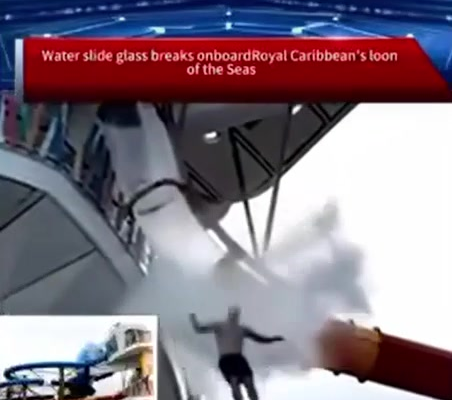When Royal Caribbean launched its crown jewel, Icon of the Seas, the company promised the ultimate blend of luxury, innovation, and thrill. This floating city—celebrated as the largest and most advanced cruise ship ever built—was designed to redefine what travelers could expect from life on the open ocean. Guests were promised elegance, adventure, and relaxation all rolled into one unforgettable experience. But that dream momentarily turned into alarm when a malfunction occurred on one of the ship’s most anticipated attractions—a towering water slide that was supposed to deliver fun and excitement, not fear. The incident, though contained quickly, has sparked a wave of concern about onboard safety and how even the most advanced vessels can face unexpected challenges.

It happened on a bright afternoon as passengers enjoyed the ship’s signature water park, known as Thrill Island. This area, featuring record-breaking slides and panoramic ocean views, had been a key marketing highlight. But during one rider’s descent, witnesses reported hearing a sharp cracking sound before realizing something had gone wrong. A transparent acrylic panel, part of the slide’s design that allowed riders to look out at the sea below, suddenly detached mid-ride. The jolt caused the rider to slow abruptly, leading to an injury. Crew members responded within seconds. The ship’s medical team, trained for emergencies at sea, treated the guest immediately. Royal Caribbean later confirmed that the individual was in stable condition and recovering comfortably under supervision. The affected attraction was shut down for inspection while safety engineers began a full investigation into what exactly caused the failure.
For passengers who had come aboard expecting nothing but carefree enjoyment, the news spread fast. Many gathered at the deck railings, peering toward the closed-off area where staff worked behind temporary barriers. Though the situation was under control, it left travelers unsettled. After all, this ship had been hailed as a modern marvel—an engineering masterpiece featuring everything from multi-story suites and fine dining venues to virtual-reality entertainment and an entire mini-amusement park at sea. The idea that something could go wrong on such a meticulously crafted vessel raised questions not only about this particular slide but also about the broader issue of safety in an era of increasingly complex cruise attractions.
Experts note that Icon of the Seas represents a new generation of ocean liners that push the boundaries of what’s possible on water. Yet, with greater innovation often comes greater risk. The ship’s designers had to balance factors like saltwater corrosion, constant motion, and extreme weather exposure—all of which can affect the durability of materials like glass and steel. In the case of this slide, the detached panel may point to a manufacturing defect, installation oversight, or environmental wear that wasn’t anticipated during testing. Royal Caribbean has not released details yet, but they’ve stated that a thorough technical review is underway, involving both internal specialists and independent maritime engineers.
The broader cruise industry has long maintained a strong safety record, emphasizing strict adherence to international maritime standards. Ships are required to undergo regular inspections, and their attractions—especially those involving speed or physical contact—must pass rigorous tests before opening to guests. Nevertheless, the recent trend toward ever-bigger, ever-bolder vessels has introduced new engineering challenges. From surf simulators and skydiving tunnels to zip lines and glass-floored observation decks, today’s cruise ships resemble small amusement parks rather than traditional liners. These additions delight passengers but also demand constant vigilance from maintenance crews. Even a minor defect can have significant consequences when thousands of people are aboard in the middle of the ocean.
While it’s important to keep this event in perspective—serious injuries on cruise ships remain exceedingly rare—it serves as a wake-up call for both the public and the industry. Passengers are right to expect transparency. How often are attractions inspected? How are materials tested for long-term exposure to sea air? And perhaps most importantly, what steps are taken to prevent such failures from happening again? The answers to these questions will determine how much trust travelers continue to place in cruise companies promising both adventure and safety.
Royal Caribbean has assured guests that passenger well-being remains their top priority. The company’s official statement praised the quick response of the crew and emphasized that all other attractions were operating normally after being reviewed for any signs of similar issues. The captain also addressed passengers directly that evening, thanking them for their patience and cooperation while the investigation proceeded. According to several attendees, his tone was calm yet sincere, acknowledging the concern while reaffirming the company’s commitment to the highest safety standards.
Behind the scenes, engineers are likely examining every detail—from design blueprints and maintenance logs to the slide’s assembly process and the materials used in its transparent components. The goal is not only to identify the cause but also to ensure that no other ship in the fleet faces a similar risk. These findings could influence how future onboard attractions are built and tested, potentially leading to updated regulations across the cruise industry.
Despite the momentary shock, many passengers have expressed appreciation for how swiftly the crew handled the emergency. Within minutes, medical assistance arrived, the area was secured, and updates were provided to those nearby. One family interviewed later described the staff’s professionalism as “reassuring in a moment of panic.” Such responses highlight an often-overlooked truth: while high-tech systems play a vital role, human training and quick thinking remain the heart of maritime safety.
As the ship continues its voyage, normalcy has largely returned. Guests have resumed exploring its sprawling decks, enjoying shows, dining under the stars, and marveling at the sheer grandeur of the vessel. Yet the memory of the malfunction lingers—a quiet reminder that even in the most luxurious settings, unforeseen problems can arise.
In the end, the water slide accident aboard Icon of the Seas underscores a delicate balance: innovation versus reliability, excitement versus responsibility. Cruise lines will undoubtedly continue pushing boundaries to attract thrill-seekers, but this incident reminds us that safety must always lead the way. For Royal Caribbean, how openly and effectively it communicates the results of this investigation will shape not only its reputation but also public trust in an industry built on the promise of unforgettable—and safe—adventure.
At sea, perfection is an aspiration, not a guarantee. Yet the measure of a company’s strength lies in how it responds when things go wrong. By taking swift action, providing care, and committing to transparency, Royal Caribbean now has an opportunity to turn a moment of concern into a model of accountability. For future passengers, that reassurance may prove just as important as the breathtaking views from the top of a water slide.





